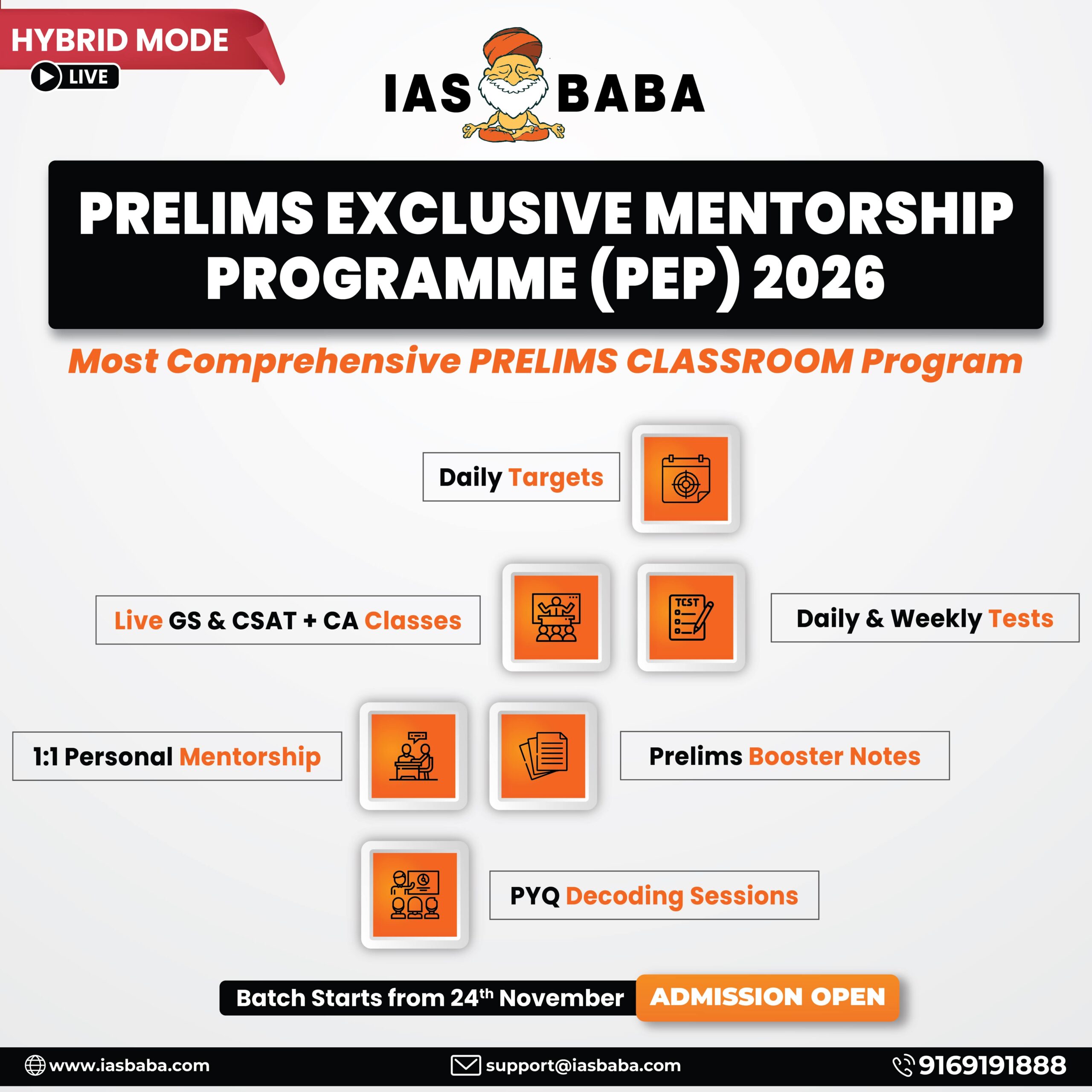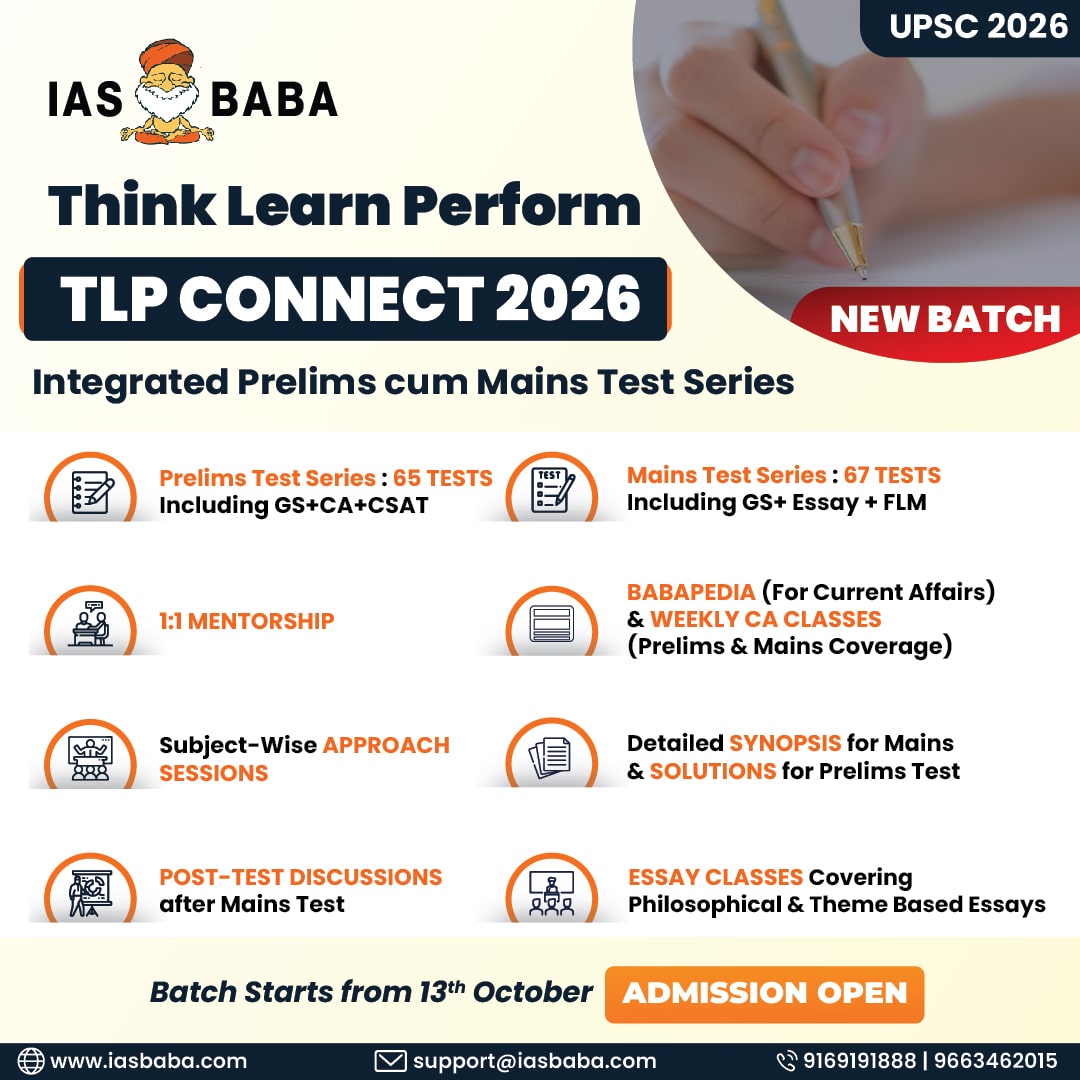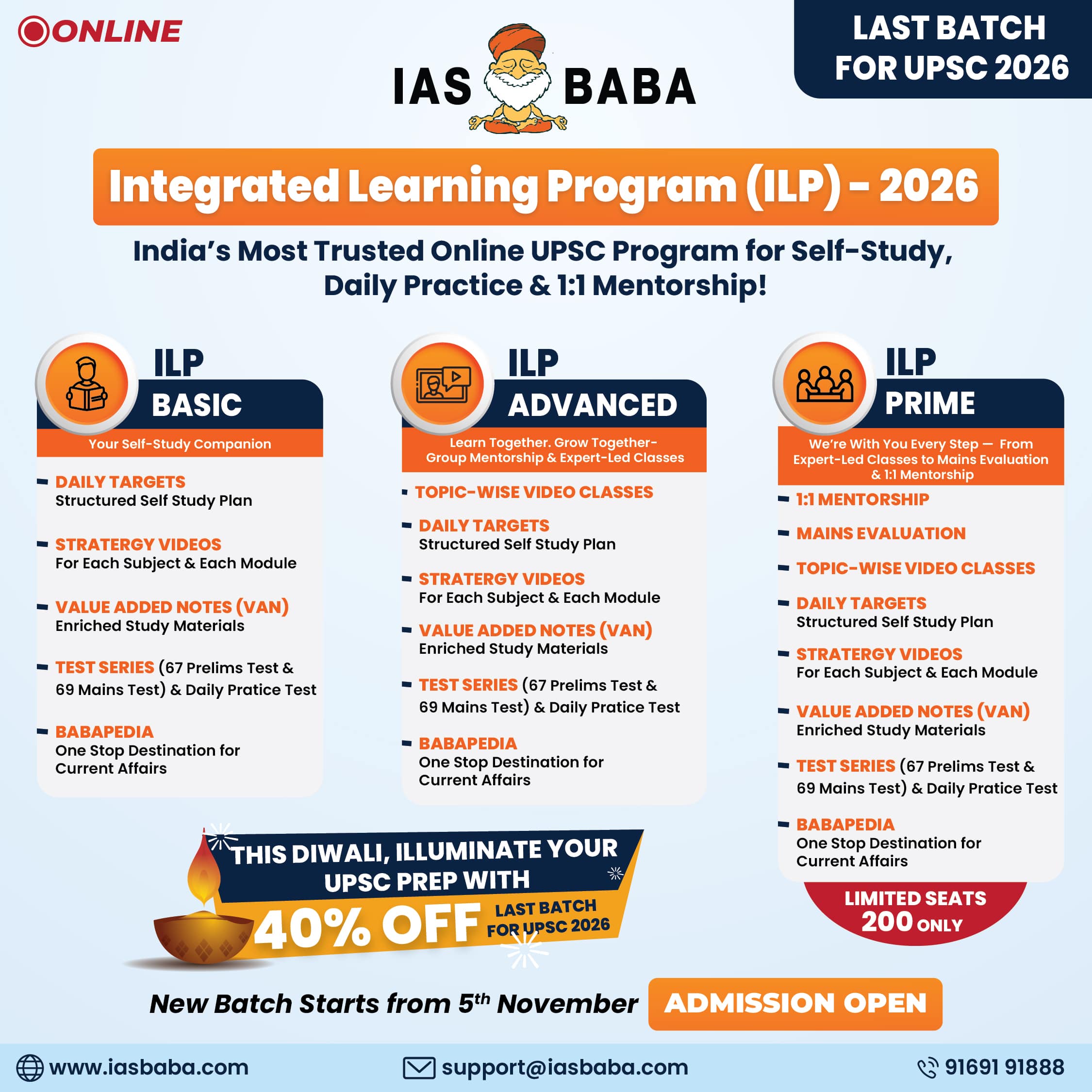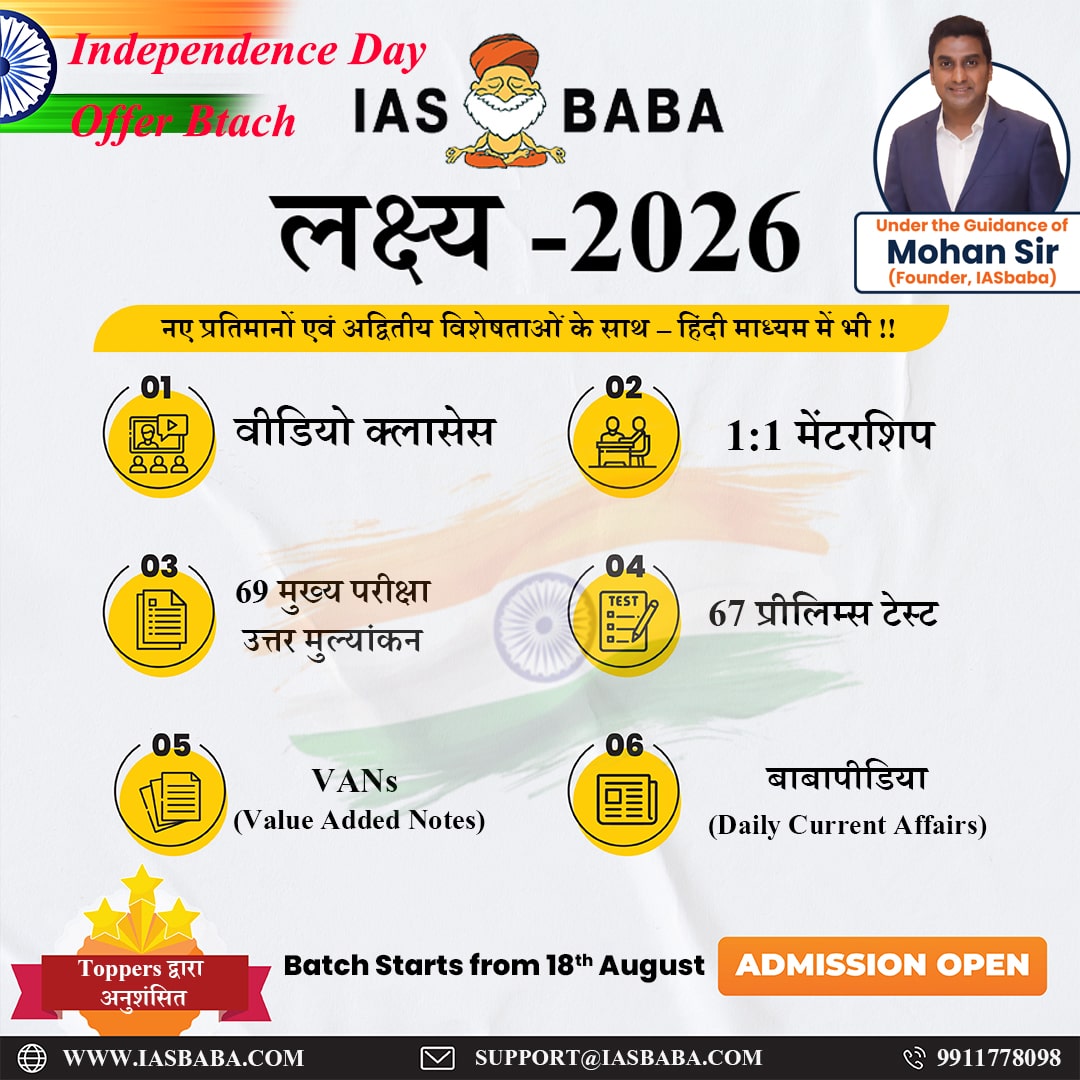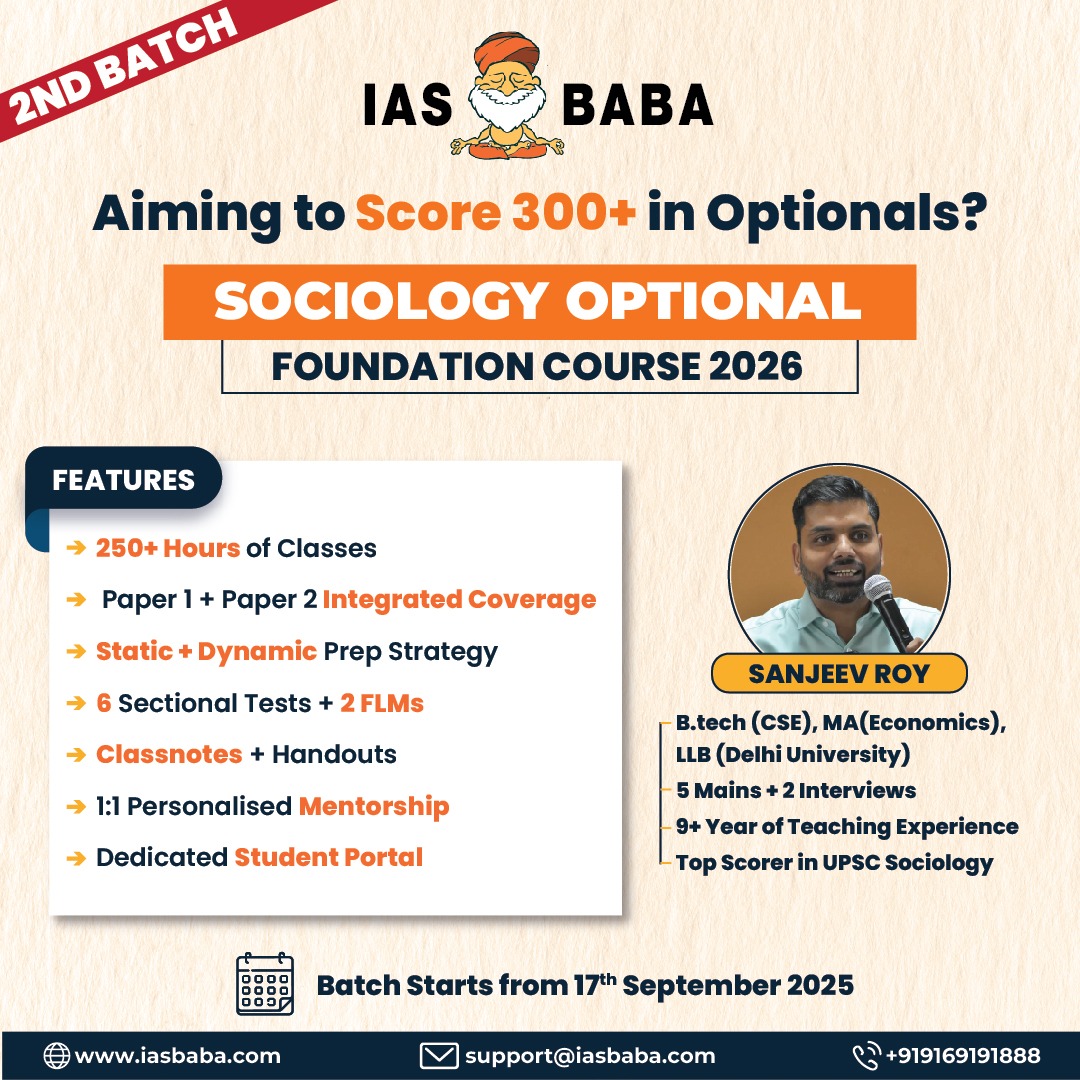IASbaba Daily Prelims Quiz
For Previous Daily Quiz (ARCHIVES) – CLICK HERE
The Current Affairs questions are based on sources like ‘The Hindu’, ‘Indian Express’ and ‘PIB’, which are very important sources for UPSC Prelims Exam. The questions are focused on both the concepts and facts. The topics covered here are generally different from what is being covered under ‘Daily Current Affairs/Daily News Analysis (DNA) and Daily Static Quiz’ to avoid duplication. The questions would be published from Monday to Saturday before 2 PM. One should not spend more than 10 minutes on this initiative.
Gear up and Make the Best Use of this initiative.
Do remember that, “the difference between Ordinary and EXTRA-Ordinary is PRACTICE!!”
Important Note:
- Don’t forget to post your marks in the comment section. Also, let us know if you enjoyed today’s test 🙂
- After completing the 5 questions, click on ‘View Questions’ to check your score, time taken, and solutions.
Test-summary
0 of 5 questions completed
Questions:
- 1
- 2
- 3
- 4
- 5
Information
To view Solutions, follow these instructions:
- Click on – ‘Start Test’ button
- Solve Questions
- Click on ‘Test Summary’ button
- Click on ‘Finish Test’ button
- Now click on ‘View Questions’ button – here you will see solutions and links.
You have already completed the test before. Hence you can not start it again.
Test is loading...
You must sign in or sign up to start the test.
You have to finish following test, to start this test:
Results
0 of 5 questions answered correctly
Your time:
Time has elapsed
You have scored 0 points out of 0 points, (0)
| Average score |
|
| Your score |
|
Categories
- Not categorized 0%
| Pos. | Name | Entered on | Points | Result |
|---|---|---|---|---|
| Table is loading | ||||
| No data available | ||||
- 1
- 2
- 3
- 4
- 5
- Answered
- Review
-
Question 1 of 5
1. Question
-
Consider the following statements regarding the Graded Response Action Plan (GRAP) Stage II:
-
Under Stage II, only CNG, electric, and BS-VI compliant vehicles are allowed to enter Delhi, with exemptions for essential services.
-
Stage II is invoked when the Air Quality Index (AQI) in Delhi-NCR remains in the “Severe” category (401-500) for 48 hours or more.
Which of the statement(s) given above is/are correct?
Correct
-
Solution (a)
Explanation:
- GRAP Stage II is activated when air quality deteriorates to the “Very Poor” category (AQI 301–400). Measures include increased mechanical road cleaning, intensified water sprinkling, and restrictions on entry of diesel trucks (except essentials)—only CNG, electric, or BS-VI vehicles are allowed entry into Delhi. Hence Statement 1 is Correct
The “Severe” category (AQI 401–500) triggers Stage III, not Stage II. Hence, Stage II corresponds to the “Very Poor” range (301–400). Hence Statement 2 is Incorrect
Incorrect
-
Solution (a)
Explanation:
- GRAP Stage II is activated when air quality deteriorates to the “Very Poor” category (AQI 301–400). Measures include increased mechanical road cleaning, intensified water sprinkling, and restrictions on entry of diesel trucks (except essentials)—only CNG, electric, or BS-VI vehicles are allowed entry into Delhi. Hence Statement 1 is Correct
The “Severe” category (AQI 401–500) triggers Stage III, not Stage II. Hence, Stage II corresponds to the “Very Poor” range (301–400). Hence Statement 2 is Incorrect
-
-
Question 2 of 5
2. Question
-
Consider the following statements regarding the Pradhan Mantri Schools for Rising India (PM SHRI) Scheme:
-
The primary objective of the scheme is to develop existing schools into model schools that demonstrate all components of the National Education Policy (NEP) 2020.
-
PM SHRI is a centrally sponsored scheme, implemented with a fund-sharing ratio of 60:40 between Centre and States (90:10 for Northeastern and hill States).
Which of the statement(s) given above is/are correct?
Correct
-
Solution (c)
Explanation:
- The PM SHRI Scheme aims to transform selected existing schools into exemplars that implement the entire vision of NEP 2020, including experiential learning, holistic assessment, and integration of vocational and environmental education. Hence Statement 1 is Correct
The scheme is centrally sponsored, not fully central sector.
It follows a 60:40 Centre–State funding pattern, and 90:10 for Northeastern, hill States, and UTs with legislature, ensuring shared fiscal responsibility. Hence Statement 2 is CorrectIncorrect
-
Solution (c)
Explanation:
- The PM SHRI Scheme aims to transform selected existing schools into exemplars that implement the entire vision of NEP 2020, including experiential learning, holistic assessment, and integration of vocational and environmental education. Hence Statement 1 is Correct
The scheme is centrally sponsored, not fully central sector.
It follows a 60:40 Centre–State funding pattern, and 90:10 for Northeastern, hill States, and UTs with legislature, ensuring shared fiscal responsibility. Hence Statement 2 is Correct -
-
Question 3 of 5
3. Question
- The CHACE-2 instrument onboard Chandrayaan-2 is designed primarily to:
Correct
-
Solution (B)
Explanation:
- CHACE-2 (Chandra’s Atmospheric Composition Explorer-2) is a quadrupole mass spectrometer developed by ISRO’s Space Physics Laboratory (SPL).
- It was one of the scientific payloads aboard Chandrayaan-2’s orbiter, designed to study the composition and distribution of the lunar neutral exosphere — the extremely thin outermost layer of the Moon’s atmosphere.
- CHACE-2 measures neutral atoms and molecules in the mass range of 1–300 atomic mass units (amu) to understand how elements like argon, helium, sodium, and other volatiles behave under lunar conditions.
- These observations help scientists study lunar surface–exosphere interactions, solar wind effects, and the spatial variation of the exosphere with time and location.
Incorrect
-
Solution (B)
Explanation:
- CHACE-2 (Chandra’s Atmospheric Composition Explorer-2) is a quadrupole mass spectrometer developed by ISRO’s Space Physics Laboratory (SPL).
- It was one of the scientific payloads aboard Chandrayaan-2’s orbiter, designed to study the composition and distribution of the lunar neutral exosphere — the extremely thin outermost layer of the Moon’s atmosphere.
- CHACE-2 measures neutral atoms and molecules in the mass range of 1–300 atomic mass units (amu) to understand how elements like argon, helium, sodium, and other volatiles behave under lunar conditions.
- These observations help scientists study lunar surface–exosphere interactions, solar wind effects, and the spatial variation of the exosphere with time and location.
-
Question 4 of 5
4. Question
-
Consider the following statements:
-
India’s entry into the Missile Technology Control Regime (MTCR) in 2016 enabled it to extend the range of the BrahMos missile beyond 300 km.
-
MTCR primarily seeks to limit the proliferation of missiles capable of delivering a payload of at least 500 kg to a range of 300 km or more.
-
Russia’s transfer of missile technology to India under the BrahMos joint venture violated MTCR norms prior to India’s membership.
Which of the statement(s) given above is/are correct?
Correct
-
Solution (a)
Explanation:
- India’s accession to MTCR in 2016 allowed it to extend the range of the BrahMos from the original 290 km (kept below the MTCR threshold) to about 450–500 km, as the restrictions on range and payload transfer between MTCR members no longer applied to India-Russia collaboration. Hence Statement 1 is Correct
- The MTCR, established in 1987, is an informal and voluntary export control regime that seeks to limit the spread of missile and unmanned delivery systems capable of carrying a 500 kg payload over 300 km or more — the threshold for nuclear-capable systems. Hence Statement 2 is Correct
Russia’s cooperation with India on BrahMos did not violate MTCR norms, because the missile’s range was deliberately capped below 300 km at that time, keeping it compliant with MTCR restrictions before India’s membership. Hence Statement 3 is Incorrect
Incorrect
-
Solution (a)
Explanation:
- India’s accession to MTCR in 2016 allowed it to extend the range of the BrahMos from the original 290 km (kept below the MTCR threshold) to about 450–500 km, as the restrictions on range and payload transfer between MTCR members no longer applied to India-Russia collaboration. Hence Statement 1 is Correct
- The MTCR, established in 1987, is an informal and voluntary export control regime that seeks to limit the spread of missile and unmanned delivery systems capable of carrying a 500 kg payload over 300 km or more — the threshold for nuclear-capable systems. Hence Statement 2 is Correct
Russia’s cooperation with India on BrahMos did not violate MTCR norms, because the missile’s range was deliberately capped below 300 km at that time, keeping it compliant with MTCR restrictions before India’s membership. Hence Statement 3 is Incorrect
-
-
Question 5 of 5
5. Question
-
Consider the following statements regarding the Indian Wolf (Canis lupus pallipes):
-
It is classified as a subspecies of the Gray Wolf and is listed as Endangered on the IUCN Red List.
-
It primarily inhabits the semi-arid grasslands and scrublands of the Deccan Plateau and Thar Desert regions.
-
In India, it is protected under Schedule I of the Wildlife (Protection) Act, 1972.
How many of the above statement(s) are correct?
Correct
-
Solution (b)
Explanation:
- The Indian Wolf is indeed a subspecies of the Gray Wolf, but it is not listed as Endangered on the global IUCN Red List — it is under ‘Least Concern’, though regionally threatened in India. Hence Statement 1 is Incorrect
- It is native to semi-arid grasslands and scrublands across peninsular and western India, particularly in Rajasthan, Gujarat, and the Deccan Plateau. Hence Statement 2 is Correct
The species is protected under Schedule I of the Wildlife (Protection) Act, 1972, providing it the highest level of legal protection. Hence Statement 3 is Correct
Incorrect
-
Solution (b)
Explanation:
- The Indian Wolf is indeed a subspecies of the Gray Wolf, but it is not listed as Endangered on the global IUCN Red List — it is under ‘Least Concern’, though regionally threatened in India. Hence Statement 1 is Incorrect
- It is native to semi-arid grasslands and scrublands across peninsular and western India, particularly in Rajasthan, Gujarat, and the Deccan Plateau. Hence Statement 2 is Correct
The species is protected under Schedule I of the Wildlife (Protection) Act, 1972, providing it the highest level of legal protection. Hence Statement 3 is Correct
-
- Current Affairs Quiz, IAS Daily Current Affairs Quiz, IAS UPSC Current Affairs Quiz, IAS UPSC Prelims Quiz, IASbaba's Current Affairs Prelims Quiz, IASbaba's Daily Quiz, IASbaba's UPSC Quiz, Prelims Current Affairs Quiz, UPSC Current Affairs Quiz, UPSC Current Affairs Quiz IASbaba, UPSC Daily Current Affair Quiz, UPSC IAS Daily Quiz



